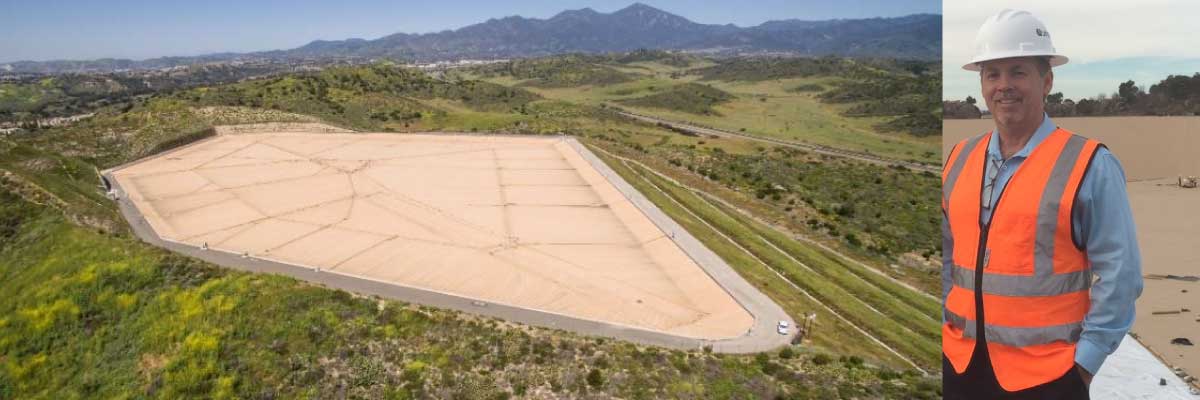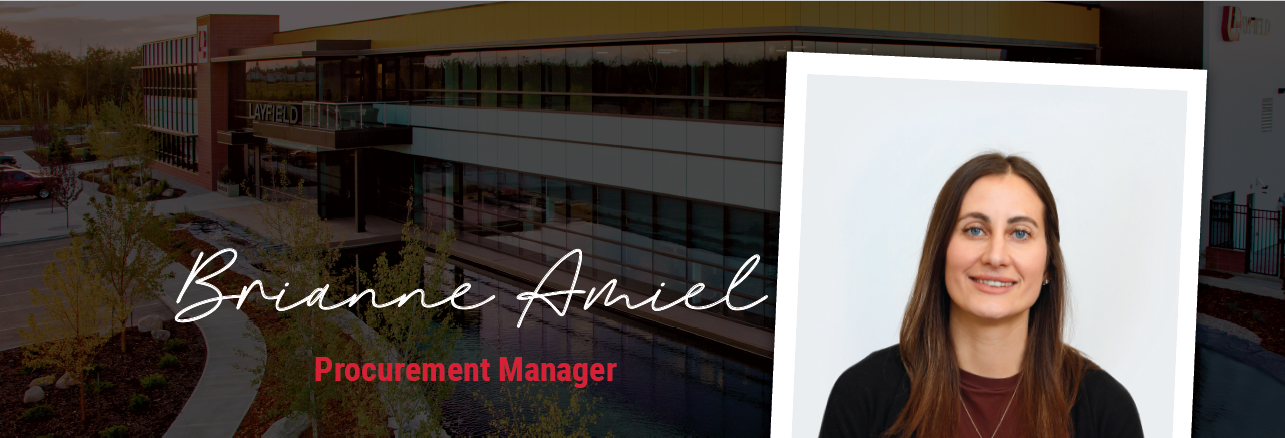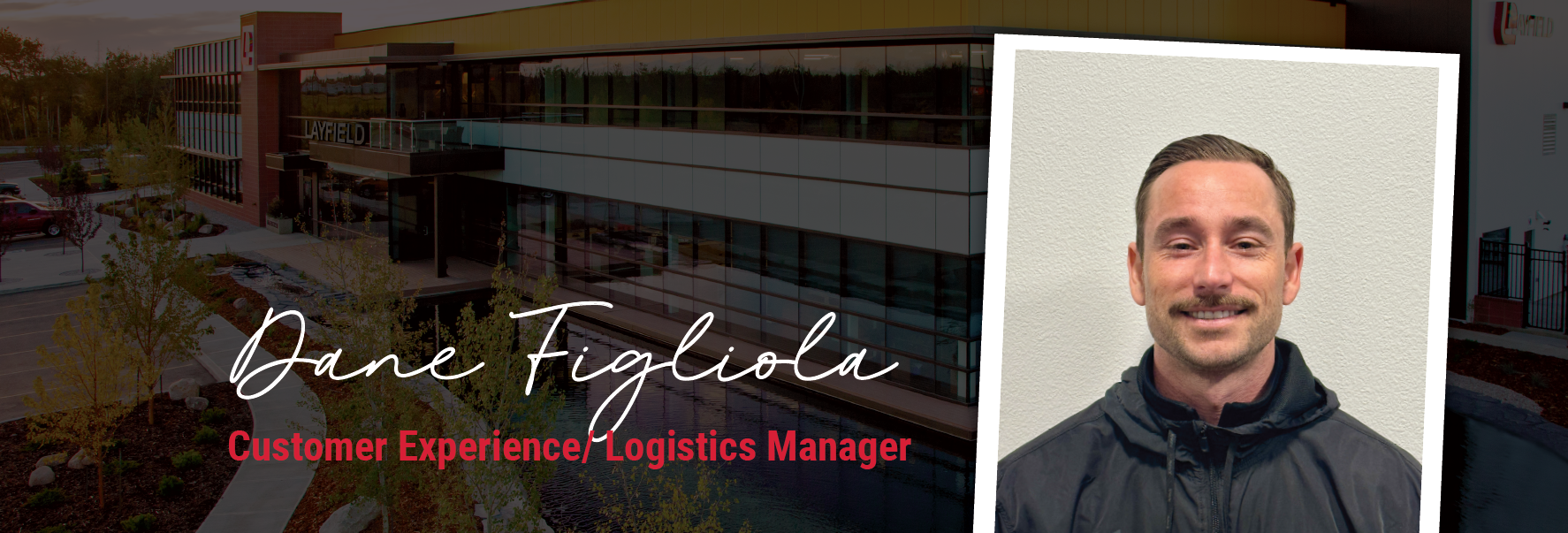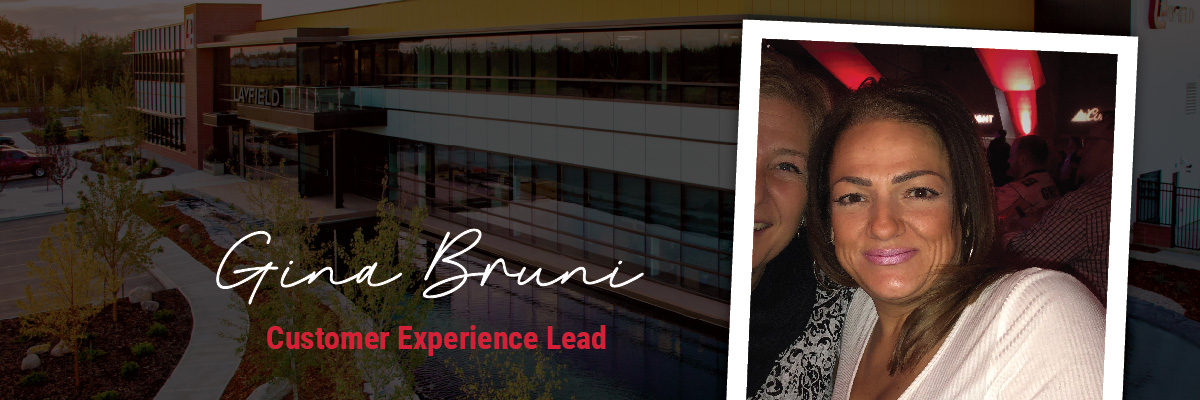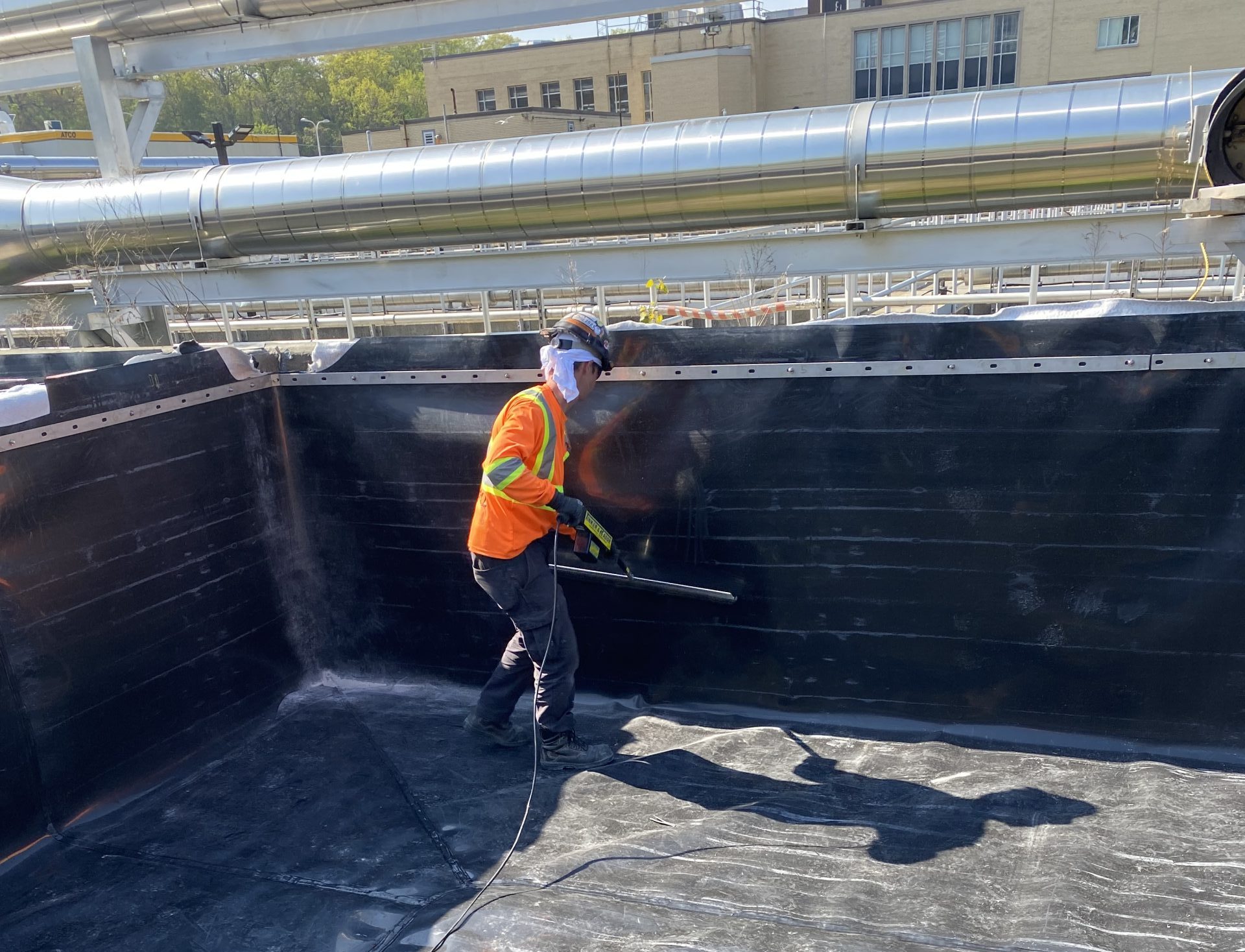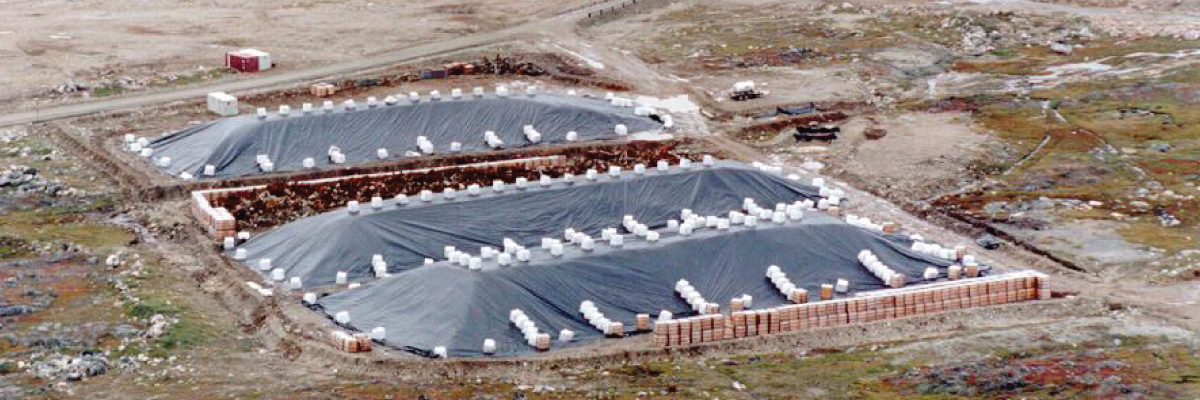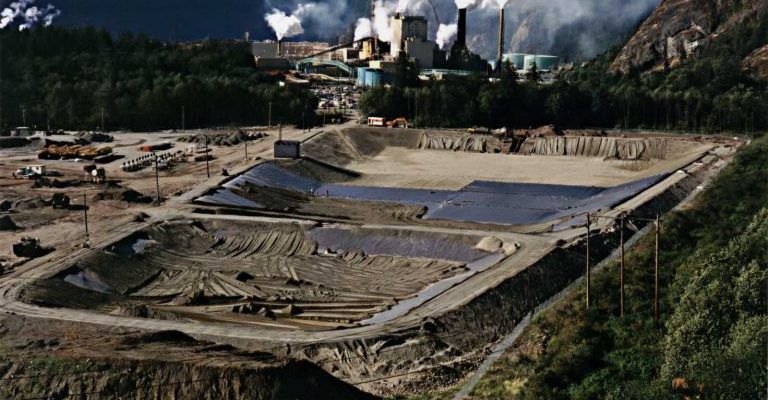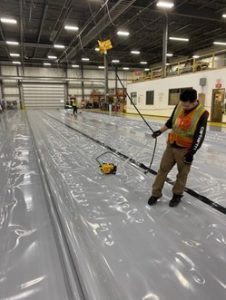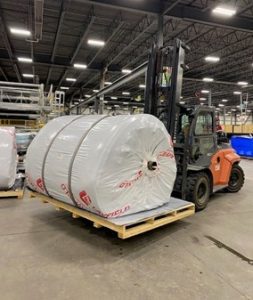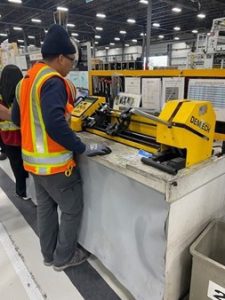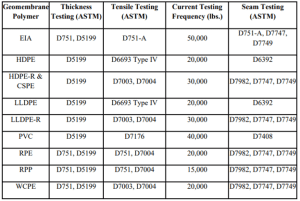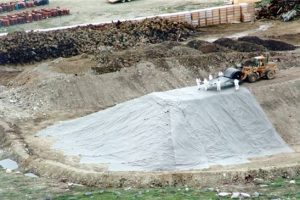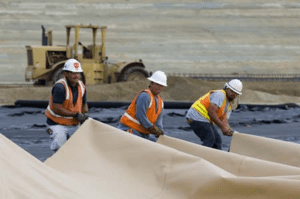Written By Brian Fraser, Vice President
Layfield Geosynthetics | February 2025
Abstract
This technote describes the application and benefits of factory-fabricated geomembrane liners through the use of flexible geomembranes. It also discusses related best practices, including material selection for flexible geomembranes and the recommended industry quality control practices for the factory welding, testing, and packaging of flexible geomembrane panels.
Benefits of Geomembrane Fabrication
There are many performance advantages to using fabricated geomembranes for environmental containment. Fabricated geomembrane liners, or factory welding of geomembranes, is the process of producing larger-size panels in a controlled factory setting. The fabrication production process involves factory welding of narrower standard manufactured rolls typically ranging from 60” to 144″ (1.52m x 3.66m) wide. This is normally done through thermal hot wedge or hot air factory welding. High-frequency welding, solvents, and adhesives are also used on certain geomembrane polymer types, including PVC and PVC EIA materials. Specialty tapes are also sometimes used for products like EPDM, which is a synthetic rubber material. A factory-produced fabricated panel can be a rectangular liner panel, a specific fabricated shape, or may contain special job-specific detail work.
The fabrication steps include unrolling and cutting to length from the manufactured roll stocks, prequalifying seam welds, welding the roll stocks into larger panels, accordion folding of the welded panels, and rolling up or winding the finished welded panels. This is followed by the final packaging and logistics of the fabricated panel.
Studies of factory-welded liners on mid- and large-size projects have shown that they reduce field welding by as much as 80%, leaving only 20% of seams requiring field welding (Stark et al., 2020). On smaller projects, i.e., under 50,000 ft2 (4,645m2), depending on the subgrade configuration, factory panels can often be provided in one large piece. These larger fabricated panels normally reduce construction time and installation costs.
Today, many industry-leading geomembrane fabricators have specially designed facilities with large open building spans, allowing for the fabrication of large rectangular and custom-configured panel shapes. Fabrication facilities also typically have special low-friction smooth floors designed to reduce surface friction to better protect material during fabrication. Many fabricators today also have automated winding equipment capable of handling panels up to 10,000 lbs. (4535 kg). Based on fabricating a 40 mil (1.0 mm) LLDPE liner, this represents a single panel size of approximately 50,000 ft2 (4,645 m2). Sizes of fabricated panels will vary based on material polymer type, thickness, and structure, whether reinforced or unreinforced.
Prior industry CQA studies have shown that approximately 80% of liner leaks occur within 3’ (1m) of field welds as a result of increased construction activities around the seams. Further studies have shown that 55% of damages and leaks recorded in ponds and landfills occurred directly at the seam (Rollin et al.(1990). With factory fabrication substantially reducing the required amount of field welds, this can provide better overall seam integrity and reduce the exposure to installation damage and leaks.
Factory fabrication can also be important to address challenging applications and geomembrane material limitations. This can include sharp transitions of grade, including tank floor-to-wall transitions, sumps, and mechanical attachment to structures, pipes, and columns. Unreinforced flexible geomembranes also provide very good multiaxial elongation properties, which is important when working with wet or weak subgrade compaction conditions. Reinforced geomembranes provide very high tensile and tear properties, which can be important in steep and vertical slope applications.
Fabrication Quality Control
The quality control process for fabricated liners includes geomembrane roll inspection, testing, and verification in compliance with specific industry ASTM test methods. Similar to field welding, factory seams require destructive control methods to determine the integrity of the welds. Fabricated liners require both pre and post-qualification seam testing performed by the fabricator. Prequalification welds of factory seams are tested in both shear and peel strength using the applicable ASTM test method based on geomembrane polymer and material structure. ASTM D6392 is normally used for testing heat-welded seams, and ASTM D6214 is for chemical welding. For reinforced geomembranes, ASTM D7982 and D7747 are commonly used. For unreinforced geomembranes, ASTM D6392, D6214, and D883 are the standard test methods. Table 1 below from the FGI Factory Fabrication Guideline shows the recommended testing methods by geomembrane type. The FGI Factory Fabrication Guideline provides a comprehensive outline of the minimum quality control (QC) practices for the factory fabrication, testing, packaging, handling, and shipping of flexible geomembrane panels.
Factory and field seam testing can also be performed in compliance with the Geosynthetic Institute GRI GM 19 and 19b standard specifications. This specification is for seam strength and related properties of thermally bonded homogeneous polyolefin geomembranes (GM 19a) and reinforced polyolefin geomembranes (GM 19b).
Nondestructive testing, including air lance testing, vacuum box testing, and mechanical point stressing, is commonly used for testing factory field welds, including testing of welded seams, patches, repairs, and cross seam intersections. Nondestructive testing is conducted as per ASTM D4437/D4437M-16(2018).
Field welding of the thinner flexible materials can be more challenging for inexperienced installers or installers who typically only install thicker gauges of HDPE and LLDPE. It is important to ensure installers are adequately experienced and certified to install flexible geomembranes.
Table 1: Testing methods for different geomembranes. FGI Factory Fabrication Guideline, Feb. 12, 2024
Please refer to ASTM D7865 (2020) for recommended industry packaging, handling, storage, and deployment standards for fabricated geomembrane panels.
Applications of Fabricated Geomembranes
Factory-welded panels are commonly used in a variety of common containment applications for municipal water, stormwater, agriculture, oil and gas, mining, and waste industries. In these applications, more flexible materials with higher tensile elongation and multiaxial properties are important. The list below shows some of the many applications where factory-fabricated panels are commonly used as geomembrane barriers and floating covers.
– Wastewater & Produced Water Ponds
– Canal and Irrigation Liners
– Tailings Ponds and Heap Leach Pads
– Above Ground Storage Tank Liners for water and brine
– Stormwater Retention Basins and Bioswales
– Agricultural Lagoons and Anaerobic Digesters
– Municipal wastewater and potable water reservoirs
– Evaporation Control Covers
– Clearwell and Reservoir Fixed and Floating Baffle Curtains
– Secondary Containment Liners for Chemicals and Hydrocarbons
– Soil Remediation Liners and Covers
– Landfill and Waste Covers, Caps and Closures
Flexible Geomembrane Materials
There are various flexible geomembrane types available today produced from different polymers, structures (unreinforced versus reinforced), and thicknesses. These materials have different performance properties, including mechanical and endurance properties. Based on the wide selection of flexible geomembranes, it is important to ensure you determine the correct material for your application. This includes determining the suitability of chemical resistance, UV stabilization, and any required mechanical performance properties. Standard material thickness for fabricated geomembranes ranges from 20 mils to 60 mils (0.5 mm – 1.5mm). Below are the main geomembranes suitable for factory fabrication:
- CSPE – Chlorosulfonated Polyethylene (Reinforced)
- EPDM – Ethylene Propylene Diene Monomer (Unreinforced)
- LLDPE – Linear Low-Density Polyethylene (Unreinforced)
- PVC – Poly Vinyl Chloride (Unreinforced)
- PVC EIA – Ethylene Interpolymer Alloy – (PVC + Ketone Ethylene Ester) – (Reinforced)
- fRPP – Flexible Reinforced Polypropylene (Reinforced)
- RPE – Reinforced Polyethylene (Reinforced)
- WCPE – Woven Coated Polyethylene (Reinforced)
Importance of Geomembrane Flexibility
Geomembrane flexibility properties are an important requirement for factory fabrication and for applications requiring higher yield elongation and multiaxial properties. Molecular weight, density, and crystallinity in polyolefin-type geomembranes, including HDPE and LLDPE materials, are important factors in flexibility. HDPE geomembranes have a higher density, molecular weight, and crystallinity, providing good overall chemical resistance but at the cost of increasing rigidity. In contrast, non-reinforced PVC, reinforced PVC EIA’s, and fRPP liners are more amorphous in their molecular structure. As a result, they demonstrate much better flexibility. It is important to note that there can be important performance tradeoffs associated with flexibility, including less chemical and UV resistance unless specially formulated.
Yield elongation is a good method of measuring geomembrane elongation and flexibility. Yield is defined as the onset of plastic deformation in the polymer under an applied load. Plastic deformation is the deformation that remains after a load is removed from a polymer sample. It is called permanent deformation. Geomembranes that have exceeded their yield elongation properties are permanently damaged. Typical industry HDPE, being a more crystalline geomembrane, has a yield point of approximately 12%. As a result, HDPE is not suitable for factory fabrication. LLDPE, RPE, PVC, PVC EIA, and fRPP demonstrate higher yield elongation properties and are suitable for factory fabrication. HDPE liners, geosynthetic clay liners (GCLs), and bituminous geomembranes (BGMs) cannot be factory fabricated and need to be installed in a field. Non-woven geotextile used for cushion fabrics can also be factory fabricated by heat welding or sewing.
Summary
It is important that design engineers and facility operators understand the advantages of fabricated liners and the use of flexible geomembranes. In environmental containment applications, no one-liner material is suitable for all applications. Flexible geomembranes can provide many performance advantages depending on the containment application. Factory fabrication of flexible geomembranes can also provide various project application advantages specific to flexibility and tensile elongation properties while reducing construction time and cost. They also provide overall better seam integrity.
Reference
FGI Factory Fabrication Guideline – https://cdn.prod.website-files.com/5977726d80d12837b9592f43/65d5022c81beb6c25c8216ab_FGI-10-2024-Factory-Fabrication-Guideline-Final-2-12-24.pdf
FGI – Fabricated Geomembrane Institute, Located at the University of Illinois at Urbana-Champaign, Dept of Civil and Environmental Engineering, 2215 Newmark Civil Eng Lab
205 N. Matthews Avenue, Urbana, IL 61801, https://www.fabricatedgeomembrane.com/
Geosynthetic Institute – GRI 19a & 19b standard specification https://geosynthetic-institute.org/grispecs/gm19a.pdf, https://geosynthetic-institute.org/grispecs/gm19b.pdf
Layfield Geosynthetics Technote – Importance of Geomembrane Flexibility – https://www.layfieldgroup.com/geosynthetics/resources/knowledge-center/the-importance-of-geomembrane-flexibility/
A Guide to Polymeric Geomembranes, A Practical approach, John Scheirs, Excelplas, https://www.excelplas.com/publications/
Rollin, A., Marcotte, M., Jacquelin, T., Chaput, L., 1999, “Leak Location in Exposed Geomembrane Liners Using an Electrical Leak Detection Technique”, Proceedings Geosynthetics ’99, IFAI, Roseville, MN, pp 615-626.
Stark, T.D., Hernandez, M.A., and Rohe, D.S., (2020). “Geomembrane Factory and Field Thermally Welded Geomembrane Seams Comparison,” Geotextiles and Geomembranes Journal, 48(4), August 2020, 454-467
Related Articles
View All News
